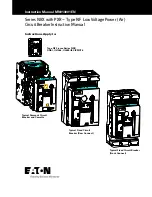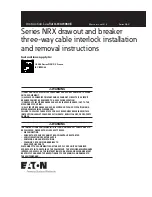
SECTION 1 1 -Type ECS Overcurrent Trip Device
The ECS is a sol id-state, d i rect-acting, self-powered
trip device system . The ECS system consi sts of the
ECS p rog rammer u n if shown in Fig. 72, cu rrent sensors,
and a flux s h i fter trip device. Fig. 73 shows a bloc k
d i ag ram of the system.
The ECS trip system essentially dupl icates the SST
t ri p system descri bed i n Section 1 0 except for the
fol lowing:
1 . Programmer un its are l i m ited fo combi nations of
Long Time, Short Time and i nstantaneous tri p elements
on ly. The Ground Fau lt element is not available.
2. Phase sensors are not tapped. As l i sted in Table 9,
each sensor has only a single ampere rating. A d i fferent
sensor is ava i lable for each of the tabu lated ampere
ratings, wh i ch span the same range as SST, see Fig. 74.
3. Neut ral sensors are not requ i red because there i s
n o G round Fau lt function.
In all other respects the ECS Tri p device system
operates and can be treated identically to SST. This in
cl udes c i rcuitry, size, const ruct ion, component loca
tion, prog ram mer u n i t set poi nts, performance
characteristics, operating range, qual ity, rel iabi l ity and
the flux shift trip device. Use the same troubleshooting
and test p roced u res for single-phase, h i g h c urrent-low
voltage tests or those em ploying the TAK-TS1 or TAK
TS2 Test Sets. The G round Fault test proced ures, of
course, do not apply. ECS phase-sensor resistance
val ues are g iven in Table 1 0.
The ti me-cu rrent characteristics for the ECS tri p
device are g iven i n c u rve G ES 6032.
1
))-- - -
FIG . 73 - ECS BLOCK DIAG RAM
56
FIG . 72
-
ECS PROG RAMMER UNIT
FIG 74
-
ECS CU RRENT SENSOR
www
. ElectricalPartManuals
. com
















































